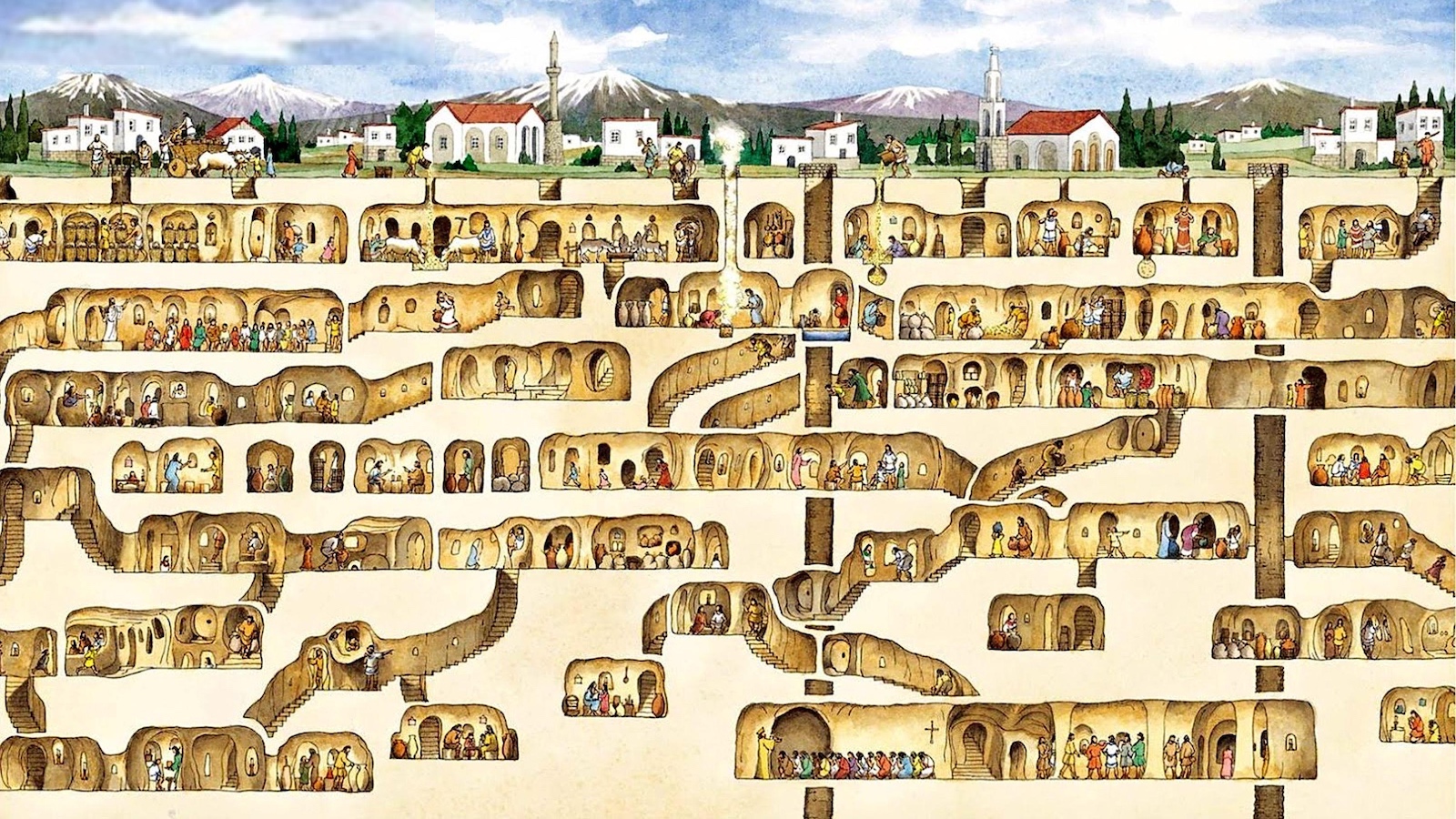Derinkuyu Underground City stands as the most impressive underground city in Turkey, a vast and awe-inspiring subterranean marvel that once sheltered thousands.
Table of Contents
Introduction
The Anatolian Plateau, where Derinkuyu is located, was often a contested region, subject to shifting empires and conflicts. Building underground shelters offered a strategic advantage: they were difficult to detect, resilient against attacks, and provided a cool, stable environment. This defensive approach allowed the Phrygians—one of the earliest civilizations to settle in central Anatolia around the 8th century BCE—to evade invaders, regroup, and survive prolonged sieges.
Over time, Derinkuyu grew into more than just an isolated underground city; it became part of a vast subterranean network in Cappadocia, connected to other hidden cities like Kaymaklı and dozens of smaller underground settlements. This intricate system of tunnels and passageways linked communities across the region, creating a fortified web of shelters where entire populations could live, worship, and protect themselves from threats.

The Fascinating History of Derinkuyu
Derinkuyu is one of the most remarkable and mysterious examples of ancient engineering. Though its initial construction is attributed to the Phrygians, its evolution continued over centuries, particularly as new threats emerged in Anatolia. When Christianity began to spread, it faced waves of persecution, prompting early Christian communities to seek hidden sanctuaries.

Under Byzantine influence, Derinkuyu grew into a well-organized underground city complete with places of worship, schools, and defensive mechanisms. Its strategic location within the rugged landscapes of Cappadocia, Türkiye, made it a prime refuge not only for Christians but for anyone seeking shelter from the region’s frequent conflicts.

Architectural Marvels and Key Features of Derinkuyu
As you wander through Derinkuyu’s narrow tunnels and expansive chambers, the ingenuity of its creators becomes evident. This underground metropolis plunges over 85 meters deep, with its 18 levels carefully designed to accommodate up to 20,000 people, including livestock. Here are some of the city’s most unique features:

- Ventilation System: Essential for life underground, Derinkuyu’s builders constructed over 50 ventilation shafts to circulate fresh air, allowing for extended periods of refuge below the surface.

- Rolling Stone Doors: These massive stone doors could seal entrances, protecting residents from intruders. Weighing up to 500 kilograms, these stones were an early yet effective form of defense.

- Religious Spaces: Reflecting its Christian heritage, Derinkuyu contains chapels and rooms arranged in cross-like shapes. These spaces served as safe havens for worship, helping maintain spiritual and communal bonds.

- Communal Spaces and Schools: Rooms believed to be used as schools and meeting areas underscore the resilience and adaptability of life underground. The Phrygians and later inhabitants managed to recreate essential parts of daily life despite being hidden from the outside world.

Connection to the Byzantine Empire and Early Christianity
As the influence of Christianity spread through Anatolia, the Byzantine Empire became a stronghold for the faith, but persecution and political tensions were never far away.
Derinkuyu, along with other Cappadocian underground cities, provided early Christians with a secret world where they could freely worship and live in relative peace. These subterranean sanctuaries also proved crucial during invasions, such as those by Arab forces. The chapels, communal kitchens, and water storage systems show how Derinkuyu evolved to meet both spiritual and survival needs.

Being located in a region that borders ancient Mesopotamia and central Anatolia, Derinkuyu became an essential part of the Byzantine defensive network. Its architectural design reflects both Roman and Byzantine ingenuity, blending functional and symbolic elements to create a space that was as much a fortress as it was a community.

How to Visit Derinkuyu Underground City
Derinkuyu Underground City is easily accessible, located about 40 kilometers south of Nevşehir in Cappadocia, Türkiye. From nearby towns like Göreme or Nevşehir, you can reach Derinkuyu by car or bus. While only the first eight levels are open to the public, they provide a fascinating experience of what life might have been like underground.
- 💰Entrance Fee: €13
It’s recommended to wear comfortable shoes and bring a light jacket, as the temperature drops the deeper you go.
Hot Air Balloon Flights over Cappadocia
While exploring Cappadocia, don’t miss the chance to witness its surreal landscapes from above. Hot air balloon rides over Cappadocia are a must-do experience, providing breathtaking views of fairy chimneys, valleys, and ancient rock-hewn villages.

These flights, especially at sunrise, are a beautiful contrast to the underground journey through Derinkuyu, offering an inspiring perspective of Türkiye’s ancient landscapes. Book your flight early, especially during peak seasons, as demand is high.

Discover Cappadocia with Us
For an in-depth experience, consider joining a guided tour. Our guides at The Other Tour offer immersive tours that delve into Derinkuyu’s historical and architectural significance, bringing to life the stories of those who once sought refuge within its walls. With an expert guide, you’ll gain unique insights into the hidden mechanisms and symbolic details woven into this underground marvel.

At The Other Tour, we offer customized, guided tours through Cappadocia, including a journey into Türkiye’s ancient past within Derinkuyu and Göreme, along with unforgettable experiences like hot air balloon rides. Whether your interests lie in historical exploration or scenic vistas, our tours provide a rich, authentic look at the region’s unique history and landscapes.








I can’t imagine how people managed to build something so deep and intricate. Is it very different from Kaymaklı, or would visiting one be enough?
Thanks for your question Luise. Yes, visiting one should usually be enough and we gotta admit that Derinkuyu is the better and deeper one but both places are great!